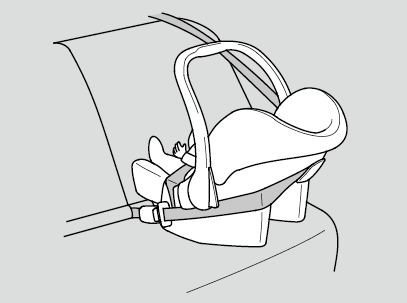Safety of Infants and Small Children
Protecting Infants
An infant must be properly restrained in a rear-facing, reclining child restraint system until the infant reaches the restraint system manufacturer's weight or height limit for the seat, and the infant is at least one year old.
When properly installed, a rear-facing child restraint system may prevent the driver or a front passenger from moving their seat all the way back, or from locking their seat-back in the desired position.
- WARNING
- Placing a rear-facing child restraint system in the front seat can result in serious injury or death if the passenger's front airbag inflates.
Always place a rear-facing child restraint system in the back seat, not the front.
- WARNING
-
Do not use a rearward facing child restraint on a seat protected by an airbag in front of it.
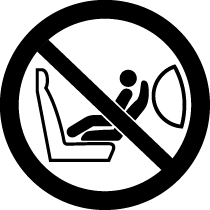
DEATH OR SERIOUS INJURY can occur.
- Detail
-
If the passenger's front airbag inflates, it can hit the rear-facing child restraint system with great force, which can dislodge or strike the system, and seriously injure the child.Rear-facing child restraint systems should never be installed in a front facing position.Always refer to the child restraint system manufacturer's instructions before installation.
Protecting Smaller Children
If a child is at least one year old and has exceeded the weight and height limitations of a rear-facing child restraint system, the child should be properly restrained in a firmly secured front facing child restraint system until they exceed the weight and height limitations for the front facing child restraint system.
-
Front facing child restraint system placement
We strongly recommend placing a front facing child restraint system in a rear seating position.
-
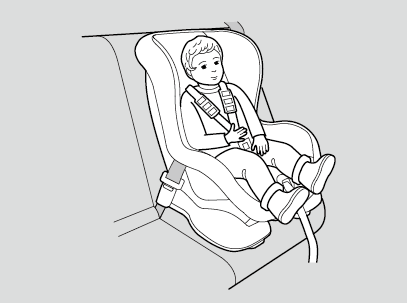
Placing a front facing child restraint system in the front seat can be hazardous. A rear seat is the safest place for a child.
- WARNING
- Placing a front facing child restraint system in the front seat can result in serious injury or death if the front airbag inflates.
If you must place a front facing child restraint system in front, move the vehicle seat as far back as possible, and properly restrain the child.
- Detail
-
Educate yourself about the laws and regulations regarding child restraint system use where you are driving, and follow the child restraint system manufacturer's instructions.Many experts recommend use of a rear-facing child restraint system for a child up to two years old, if the child's height and weight are appropriate for a rear-facing child restraint system.
Selecting a Child Restraint System
Important consideration when selecting a child restraint system
Make sure the child restraint system meets the following three requirements:
- The child restraint system is the correct type and size for the child.
- The child restraint system is the correct type for the seating position.
- Child restraint system is compliant with safety standard. We recommend the child restraint system with the UN-ECE R44 or the regulations of the subject countries. Look for the approval mark on the system and the manufacturer's statement of compliance on the box.
The Recommended Child Restraint System for India
Various types of child restraint systems are available. Not all types are suitable for your vehicle. Please refer to the table below to select which category of child restraint system can be used on each seating position.
|
Mass group
|
Seating position
|
|||
|---|---|---|---|---|
|
Front passenger
|
Rear passenger
|
|||
|
Rear Left/Right side
|
Rear centre
|
|||
|
group 0
|
Up to 10 kg
|
X
|
U
|
X
|
|
group 0+
|
Up to 13 kg
|
X
|
U
|
X
|
|
group I
|
9 kg to 18 kg
|
UF*1
|
U
|
X
|
|
group II
|
15 kg to 25 kg
|
UF*1
|
U
|
X
|
|
group III
|
22 kg to 36 kg
|
UF*1
|
U
|
X
|
|
U:
|
Suitable for "universal" category restraints approved for use in this mass group.
|
|
UF:
|
Suitable for front facing "universal" category restraints approved for use in this mass group.
|
|
X:
|
Seat position not suitable for children in this mass group.
|
|
*1:
|
Adjust the seat-back angle to the upright position (front most lock position).
|
A size class is specified for some child restraint systems. Make sure to check the size class as indicated on the manufacturer's instructions, package, and labels of the child restraint.
For a correct installation, please refer to the Child Restraint Instruction Manual.
Installing a Child Restraint System with a Lap/Shoulder Seat Belt
-
- Make sure to lock the seat-back in the upright position.
- Lower the head restraint to its lowest position.
- Place the child restraint system on the vehicle seat.
- Route the seat belt through the child restraint system according to the child restraint system manufacturer's instructions, and insert the latch plate into the buckle.
- Insert the latch plate fully until it clicks.
-
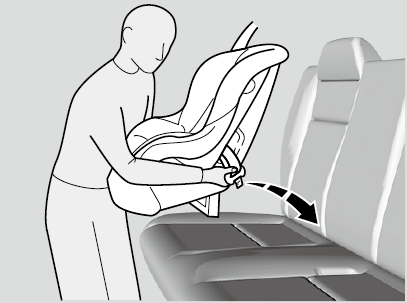
-
- Push down the tab. Route the shoulder part of the belt into the slit at the side of the restraint.
- Grab the shoulder part of the belt near the buckle, and pull up to remove any slack from the lap part of the belt.
- When doing this, place your weight on child restraint system and push it into the vehicle seat.
- Position the belt properly. Make sure the belt is not twisted.
- While pulling down the tab, pull up the upper shoulder part of the belt to remove any slack from the belt.
-
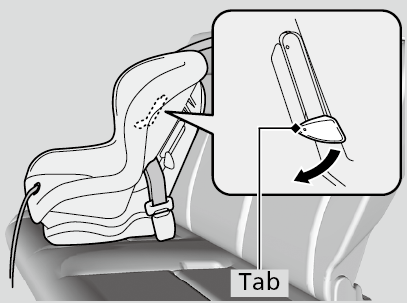
-
- Make sure the child restraint system is firmly secured by rocking it forward and back and side to side; little movement should be felt.
- Make sure any unused seat belt that a child can reach is buckled.
-
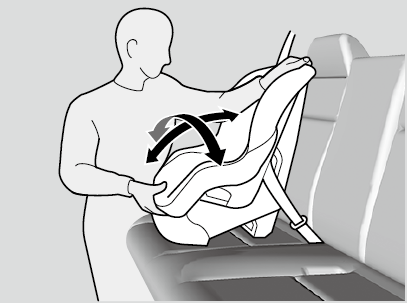
- If your child restraint system does not come with a mechanism that secures the belt, install a locking clip on the seat belt.
After going through the step 1 to 4, pull up the shoulder part of the belt and make sure there is no slack in the lap portion.- Tightly grasp the belt near the latch plate. Pinch both parts of the belt together so they do not slip through the latch plate. Unbuckle the seat belt.
- Install the locking clip as shown in the image. Position the clip as close as possible to the latch plate.
- Insert the latch plate into the buckle. Go to step 7 and 8.
-

- Detail
-
To check if the lap/shoulder belt is equipped with the lockable retractor, pull the lap part of the lap/ shoulder belt all the way out, let the belt retract slowly, then pull the belt again gently. If the belt is locked, the belt is equipped with the lockable retractor.A child restraint system that is not properly secured will not adequately protect a child in a crash and may cause injury to the child or other vehicle occupants.
Installing a Child Restraint System with a Lap Belt*
-
- Place the child restraint system on the vehicle seat.
- Route the seat belt through the child restraint system according to the child restraint system manufacturer's instructions, and insert the latch plate into the buckle.
- Insert the latch plate fully until it clicks.
- Pull hard on the loose end of the belt to remove any slack.
- When doing this, place your weight on the child restraint system and push it into the vehicle seat.
- Make sure the child restraint system is firmly secured by rocking it forward and back and side to side; little movement should be felt.
-
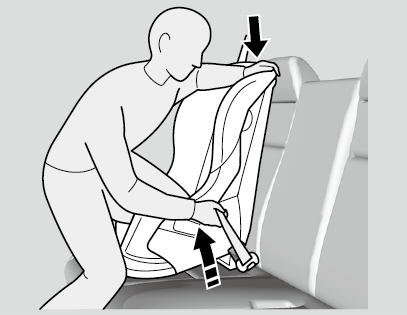
* Not available on all models
- Recommend page
